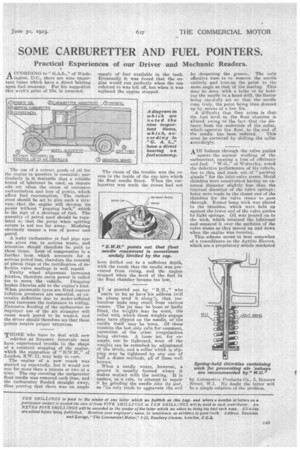SOME CARBURETTER AND FUEL POINTERS.
Page 29

If you've noticed an error in this article please click here to report it so we can fix it.
Practical Experiences of our Driver and Mechanic Readers.
A CCORDING to " G.A.L.," of Washington, D.C., there are nine important items which have a direct Waring upon fuel economy. For his suggestion this week's prize of lris. is awarded.
The use of a correct grade of oil for the engine in question is essential; particularly is it desirable that a reliable brand of lubricant be used, as impure oils are often the cause of excessive carbonization and loss of power, which affect fuel consumption. The carburetter shout(' be get to give such a mixture that the engine will develop its power without "popping back," which is the sign of a shortage of fuel. The quantity cf petrol used should be regulated so that the point when spitting occurs ia not too far away. Misfiring obviously causes a loss of power and petrol.
A leaky carburetter or fuel pipe system gives rise to serious waste, and attention should therefore be paid to these items. Loss of compression is a further item which accounts for a serious petrol loss, therefore the renewal of piston rings or the rectification of defective valve Beatings is well repaid.
Faulty wheel alignment increases friction, therefore extra power is called for to move the vehicle. Dragging brakes likewise add to the engine's load. When pneumatic tyres are fitted correct inflation pressures are essential, as excessive deflection due to under-inflated tyres increases the resistance to rolling. Excessive flooding of the carburetter or improper use of the air strangler will cause much petrol to be wasted, and the driver should therefore see that these points receive proper attention.
THOSE who have to deal with new vehicles at frequent intervals may have experienced trouble in the shape of a constant stopping of the engine, which the suggestion of " B.W.H.," of London, S.W. 11, may help to cure.
The engine of a new coach was started up repeatedly, but it would not run for more than a minute or two at a time. The cap covering the carburetter float needle was removed each time, and the carburetter flooded straight away, thus proving that there was an ample supply of fuel available in the tank. Eventually it was found that the engine would run perfectly when the cap referred to was left off, but when it was replaced the engine stopped.
The cause of the trouble was the recess in the inside of the cap into which the float needle fitted. When the carburetter was made the recess had not been drilled out to a sufficient depth, with the result that the needle was prevented from rising, and the engine stopped when the level of the fuel in the float chamber became too low.
IT is pointed out by " R.H.," who omits to let us have his address (will W please send it along ?), that carburetter leaks may result from various causes. The jet may be loose or badly fitted, the weights may be worn, the collar with which those weights engage may have slipped on the needle, or the needle itself may be worn. Of these troubles the last only calls f or comment, correction of the other irregularities being obvious. A loose jet, for example, can be tightened, wear of the weights can be remedied by adjustment of the levels, and a collar which is slipping may be tightened by any one of half a dozen methods, all of them well known.
When a needle wears, however, a groove is usually formed where it makes contact with the seating. It is useless, as a rule to attempt to repair i4 by grinding the needle into its seat,
as only tends to aggravate the evil
by deepening the groove_ The only effective cure is to remove the needle entirely and true-up the point to the same angle as that of the seating. This may be done with a lathe or by holding the needle in a hand drill, the Hatter being carefully set so that the needle runs truly, the point being then dressed up by means of a fine file.
A difficulty that then arises is that the fuel level in the float chamber is altered owing to tho fact that the distance from the underside of the collar, which operates the float, to the end of
the needle has been reduced. This must be corrected by shifting the collar accordingly.
AIR leakage through the valve guides upsets the normal working, of the carburetter, causing a loss of efficiency and fuel. " W.G.," of Wolverley, noted the defective performance of his vehicle, due to this, and made use of "packing glands" for the inlet-valve stems. Metal thimbles were constructed having an external diameter slightly less than the internal diameter of the valve springs ; holes were made in the closed end of the thimbles for the valve stems to pass through. Round lamp wick was placed in the thimbles, which were held up against the lower end of the valve guides by light springs. Oil was poured on to the wick, which retained the lubricant and smeared it over the surfaces of the valve stems as they moved up and down when the engine was running.
This scheme seems to bear somewhat of a. resemblance to the Ayrtite Sleeves, which are a proprietory article marketed
by Automotive Products Co., 3, Berners _Street, W.1. No doubt The latter will be a simple solution of the problem.






























